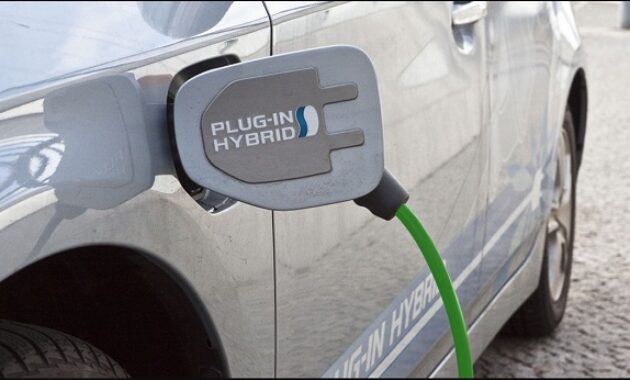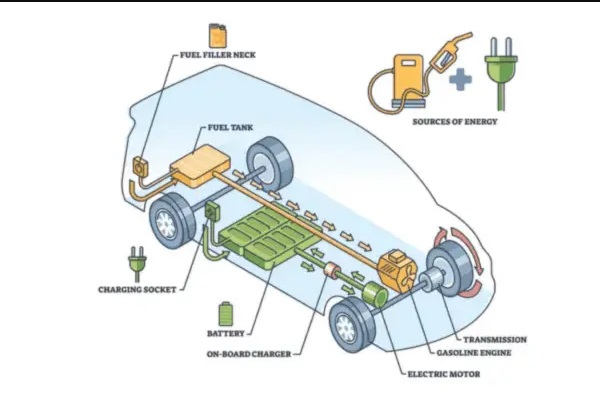Plug-in hybrid vehicles—PHEVs—are set to rescue the automotive industry. Additionally, they could contribute to environmental preservation. At least, that’s the idea. The truth, however, is more complex.
The recent decline in electric vehicle sales has exposed an uncomfortable reality in the auto industry: you can encourage consumers to explore a new technology, but you cannot compel them to purchase it. Electric vehicles remain relatively costly and, compared to traditional internal combustion engine vehicles, can be less convenient. Charging a battery is still a lengthier process than refueling a gas tank, and charging stations are not nearly as widespread as gas stations. While early adopters may have embraced the shift, many typical car, truck, and SUV purchasers are still hesitant.
Automakers who heavily invested in electric vehicles in recent years are now reconsidering their overall business approaches. For instance, Bentley, which promised four years ago to produce only electric vehicles by 2030, now states it will continue manufacturing internal combustion engine cars and SUVs until at least 2035. Like many automakers quickly shifting focus away from electric technologies, Bentley emphasizes that these vehicles will be plug-in hybrids.

There is solid reasoning behind the PHEV idea. It can operate as an electric vehicle until its battery depletes. Once that happens, the internal combustion engine kicks in, allowing travel without the worry of limited range. Until recently, the electric-only driving range of these vehicles was quite limited, with many PHEVs only managing around 20 miles before the battery ran out. However, a new generation of PHEVs with larger batteries can now achieve more than 60 miles without activating the internal combustion engine.
Why are manufacturers so committed to plug-in hybrids? Automakers are converging on the high-capacity battery PHEV design. While PHEV powertrains are intricate and expensive to implement, and tend to add unwanted weight to a vehicle, car companies view them as a solution that bridges the divide between traditional combustion vehicles and electric ones, providing consumers with the advantages of both with relatively few trade-offs. For the most part, this is accurate. But if anyone assumes PHEVs are a flawless solution, they should reconsider.
Though they are versatile, PHEVs are most advantageous in a specific context, particularly in urban and suburban settings. On average, Americans drive approximately 42 miles daily, primarily for commuting, taking children to school, or attending events in cities and suburbs. If you can recharge your large-battery PHEV overnight, you could manage most of your daily driving without needing to engage the internal combustion engine.
However, if your driving patterns frequently involve longer distances, a PHEV may not be financially beneficial, as I discovered during a recent long journey in the Mercedes-Benz C300e. This car represents the PHEV version of the C-Class and integrates a 2.0-liter turbocharged four-cylinder gas engine that produces 201 horsepower and 236 lb-ft of torque with an electric motor that boosts combined output to 308 hp and 406 lb-ft. A 25.4-kWh battery provides the vehicle with an electric range of 62 miles according to the European WLTP test protocol. (It is worth noting that WLTP figures often tend to be optimistic compared to EPA testing.)
The C300e began the journey with a full gas tank and a battery at 70 percent charge. Operating in Hybrid Auto mode, the PHEV traveled 43 miles using only electric power before the gasoline engine engaged, and the powertrain management system began optimizing efficiency using both power sources. At 88 miles into the trip, the computer indicated that the e-motor had contributed to 47 percent of the total distance covered, achieving an overall fuel efficiency equivalent to 69 mpg. However, by the end of the journey, covering 327 miles, the overall fuel economy displayed dropped to just 34 mpg.
For comparison, the standard C300 sedan sold in the U.S. has an EPA rating of 35 mpg on the highway. And here’s the interesting part: in Germany, the C300e is priced 12.2 percent higher than an equally equipped C300.
If you undertake a significant amount of long-distance travel, especially trips exceeding the 60-mile threshold, the economic appeal of PHEVs diminishes. This is particularly true since the large-battery PHEVs lack the rapid charging capability of the newest EVs. The C300e can handle a peak charging rate of 55 kW, meaning it takes 20 minutes to charge the battery from 10 percent to 80 percent. That may seem reasonable until you realize you’ve added only about 40 miles of electric driving range, which doesn’t amount to much if you’re situated between Denver and Des Moines.
Better Alternatives Are Available
While it may not be fashionable now, the most effective engine for long-distance travel remains a diesel—my Mercedes E220d wagon, equipped with a 2.0-liter turbodiesel engine, is larger and more luxurious than the C300e (and notably about 600 pounds lighter), would have achieved 42 mpg or better on the same 327-mile round trip. However, with diesel not being viable in the U.S., the next best option for fuel efficiency over long distances appears to be an advanced mild hybrid like the Audi MHEV+ system found in the new S5 for the European market.
MHEV+ serves as a sophisticated mild hybrid that reduces the operation time of the internal combustion engine during driving without requiring a plug-in charging station. It consists of a belt alternator starter, an electric motor situated next to the engine and transmission that acts on the transmission output shaft, and a water-cooled 1.7-kWh lithium-iron-phosphate battery. This system can provide up to 24 hp and 169 lb-ft of torque as needed and can recover as much as 25 kW through braking and deceleration.
The belt alternator starter is employed to initiate the engine and transfer electrical energy to the battery. Since the e-motor—referred to as the powertrain generator in Audi terminology—operates directly on the transmission’s output shaft, the generated or recovered power does not need to pass through the transmission, allowing its use in both front-wheel and all-wheel-drive configurations. The e-motor is capable of assisting the internal combustion engine at speeds up to 87 mph.
Although the S5’s MHEV+ system permits driving short distances on electric power at lower speeds, its design focuses more on rapidly depleting and replenishing the battery rather than maximizing electric driving range. According to Audi, this approach facilitates the recovery and efficient use of the most energy for propulsion. The lithium-iron-phosphate battery plays a crucial role in this process: its chemistry supports thousands of rapid charge and discharge cycles with minimal effect on overall capacity, as claimed by Audi.
Audi states that MHEV+ contributes to the S5 achieving nearly 8 percent better fuel efficiency compared to its predecessor, the S4, even though it offers 4 percent more power and 10 percent more torque. On a long highway journey, the S5 is expected to average nearly 32 mpg. While this is not as impressive as a diesel—Audi previously sold a version of the older S4 in Europe featuring the 3.0-liter TDI V-6 diesel that attained almost 38 mpg on the highway—it represents progress in the right direction.
The Optimal Alternative Is…
Yet it’s merely a step forward. There is a hybrid powertrain that can genuinely provide the best of both worlds—extremely low emissions coupled with minimal range anxiety—but the automotive industry has been cautious about adopting it until lately for various reasons. This powertrain configuration is known as a series hybrid, which employs an internal combustion engine as a generator to supply electric power to the motors that propel the vehicle. More commonly referred to as EREV (extended-range electric vehicle) systems, Chinese manufacturers have been aggressively investing in this technology. The Chevrolet Volt was one of the first EREVs in the U.S. (although its engine occasionally powered the wheels), and Ford, Hyundai, and Stellantis all have significant plans for EREVs. Stellantis’ Ram 1500 Ramcharger will be among the first new-generation EREVs available for purchase here, boasting up to 690 miles of total range. Indeed, the sales of the Ramcharger were accelerated for the first half of this year.
The primary benefit of this system is that since the internal combustion engine is not directly connected to driving the wheels, it can be optimized to operate consistently at its most efficient speed; there’s no need for constant over-fueling to meet ever-changing torque demands. Consequently, emissions are very low and can be easily managed. Additionally, an internal combustion engine designed solely for generating electricity can be lighter, smaller, and can operate on various liquid fuels, including biofuels, for which an extensive distribution network is already in place.
Back in the early 1990s, I attended a conference on electric vehicles where the keynote speaker was Howard Wilson, a former Hughes Aircraft Corporation engineer who played a significant role in developing the solar-powered GM Sunraycer and guiding the production of GM’s revolutionary EV1 electric car (although it was in limited quantities). I inquired of Wilson about any modifications he would make to the EV1, which at the time was arguably the most technically advanced vehicle globally. He replied, “What I’d really like to do is install a small gas turbine engine that could run at a constant speed to provide the electricity for the motors.” In other words, he envisioned it as a series hybrid. “Fuel consumption would be low, emissions would be tiny, and you’d be able to drive it much further.”
More than three decades later, those statements still hold true.
What’s the Difference Between Hybrid and Plug-In Hybrid Vehicles?
Equip yourself with knowledge when seeking a new, environmentally friendly vehicle. Before visiting your nearby dealership, it’s beneficial to grasp the distinctions between hybrid and plug-in hybrid cars (PHEVs). Each type of vehicle presents unique advantages for drivers who are mindful of their ecological impact. HEVs seamlessly integrate gasoline and electric energy, making them ideal for city driving. Plug-in hybrid vehicles (PHEVs) provide a longer electric-only range, perfect for those desiring more electric driving and reduced trips to the gas station.
Key Differences Between a Hybrid and Plug-in Hybrid
If you are in the market for a hybrid-electric vehicle, it’s important to recognize the primary differences between a hybrid and a plug-in hybrid vehicle (commonly known as HEV and PHEV, respectively). Familiarizing yourself with these differences can aid you when you visit the dealership to select your new vehicle. Although the terms “hybrid” and “plug-in hybrid” are frequently used interchangeably, there are significant distinctions between these two vehicle types that could affect your choice.
What is a hybrid vehicle?
Hybrid vehicles, often called HEVs, utilize both an internal combustion engine and an electric motor system that collaborate to enhance fuel efficiency and reduce emissions. Some HEVs are capable of alternating between the two power sources or even using both at the same time, depending on driving circumstances and powertrain design.
What is a PHEV vehicle?
Plug-in hybrid vehicles, or PHEVs, expand upon the hybrid concept. In addition to featuring both a gasoline engine and an electric motor, PHEVs include larger batteries that can be charged by connecting to an external power source, like a standard electrical outlet or a charging station. This design allows PHEVs to offer a more extensive electric-only driving range, enabling them to often cover considerable distances solely using electric power before the gasoline engine activates.
The primary difference between a hybrid and a plug-in hybrid mainly revolves around battery size, ratings for all-electric driving range, and methods of charging. While full HEVs depend on regenerative braking and their internal combustion engines to recharge their batteries, plug-in HEVs also allow for recharging the battery through compatible equipment. This additional flexibility enables PHEV owners to emphasize electric driving, which decreases their dependence on gasoline and further diminishes their environmental impact.

What Are the Benefits of a Hybrid Vehicle?
Hybrid vehicles are making notable contributions to the automotive sector by providing numerous advantages that attract environmentally aware drivers and those aiming to save money on fuel.
Here’s a deeper look at why hybrid vehicles are gaining popularity:
- Hybrid vehicles deliver improved fuel efficiency. By merging the capabilities of an internal combustion engine with an electric motor system, HEVs can attain better mileage than gasoline-only vehicles. The electric motor system activates during low-speed travel and acceleration, diminishing the burden on the gasoline engine and conserving fuel in the process.
- Regenerative braking systems offer additional benefits compared to conventional brakes. This technology captures and retains energy that would otherwise be lost during braking. When brakes are applied, the electric motor functions as a generator, transforming kinetic energy into electrical energy and storing it in the battery for future use. This can help increase fuel efficiency and extend the lifespan of the brakes, resulting in savings on both fuel and maintenance costs.
- Hybrid vehicles produce reduced emissions. With increasingly stringent emissions regulations and heightened environmental concerns, cutting carbon emissions has become a primary focus for many drivers. Hybrid vehicles emit fewer pollutants than traditional gasoline-powered cars because they can partly run on electric energy. This characteristic makes HEVs attractive to drivers who wish to lessen their carbon footprint and support a cleaner environment.
What Are the Benefits of a PHEV?
Plug-in hybrid electric vehicles (PHEVs) provide various advantages, combining the best features of both hybrid and electric vehicles. Below are some notable benefits that make PHEVs appealing for eco-friendly drivers:
- PHEVs feature a longer electric-only range compared to traditional hybrid vehicles. PHEVs are equipped with larger batteries that can be charged by plugging into an external power source, allowing them to cover considerable distances using only electric power.
- PHEVs provide the convenience of charging the battery without the need to operate the vehicle. This enables drivers to maximize their usage of the vehicle’s electric-only capability, thereby conserving fuel.
- PHEVs generate fewer emissions than gasoline-powered vehicles and certain hybrid models, as they can operate for extended periods using electric motors, thanks to the option to charge
- PHEVs with suitable equipment. This positions PHEVs as a leading choice for drivers keen on minimizing their environmental footprint without fully committing to electric vehicles.
Lastly, some PHEV purchases may enable drivers to access tax breaks and rebates provided by local, state, and federal governments, which can help reduce the initial cost of a PHEV.
Hybrid VS. PHEV – Which is Superior?
There are subtle yet important distinctions between hybrid and plug-in hybrid vehicles. The final choice depends on your personal requirements and priorities.
Are you in search of a vehicle that offers improved fuel efficiency and a possible decrease in environmental pollutants? If so, a hybrid vehicle might serve as a suitable introduction to the realm of electrified automobiles.
If your goal is to experience the advantages of a hybrid along with a longer electric-only driving range, the option to charge your traction battery at home or at a charging station, and often superior performance compared to HEV versions of the same model, then a plug-in hybrid could be the right choice for you.
In the end, whether you choose a hybrid or a PHEV will depend on your driving patterns, lifestyle, and financial considerations. Both alternatives hold significant benefits, so it’s beneficial to evaluate the main differences between hybrid and plug-in hybrid vehicles to make an educated decision.


